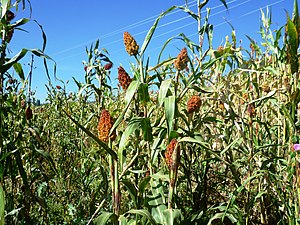
To cultivate Indian Corn.
from the Household Cyclopedia, 1881
The land should be a loamy sand, very rich. In April the grains should be set like hops, at three to four feet distance, three to six grains in a hill, each grain about an inch deep in the ground. The seed from New England is the best. In May the alleys should be hoed and the hills weeded and earthed up higher; many good farmers plough three times after planting. At the latter end of that month all the superfluous stalks should be taken away, and only three stems of corn left in each hill. By the middle of June, it will cover the alley. It grows much like bulrushes, the lower leaves being like broad flags, three or four inches wide, and as many feet in length; the stems shooting upwards, from seven to ten feet in height, with many joints, casting off flag-leaves at every joint. Under these leaves and close to the stem grows the corn, covered over by many coats of sedgy leaves, and so closed in by them to the stem, that it does not show itself easily till there bursts out at the end of the ear a number of strings that look like tufts of horsehair, at first of a beautiful green, and afterwards red or yellow, the stem ending in a flower. The corn will ripen in October or early November; but the sun at that season not having strength enough to dry it, it must be laid upon racks or thin open floors in dry rooms, and frequently turned, to avoid moulding; the grains are about as big as peas, and adhere in regular rows round a white pithy substance, which forms the ear. An ear contains from two to four hundred grains, and is from six to ten inches in length. They are of various colors, blue, red, white and yellow. The manner of gathering them is by cutting down the stems and breaking off the ears. The stems are as big us a man’s wrist, and look like bamboo cane; the pith is full of a juice that tastes as sweet as sugar, and the joints are about a foot and a half distant. The increase is upwards of five hundred fold. Upon a large scale the seed may be drilled in alleys like peas, and to save digging, the ground may be ploughed and harrowed, which will answer very well. It will grow upon all kinds of land. The ears which grow upon dry sandy land are smaller, but harder and riper. The grain is taken from the husk by hand, and when ground upon stones, makes an excellent flour, of which it yields much more, with much less bran, than wheat does, and exceeds it in crust, pancakes, puddings, and all other uses except bread; but a sweetness peculiar to it, which in all other cases makes it agreeable, is here less so. It is excellent for feeding horses, poultry and hogs, and fattens them much better and sooner than peas or barley. The stems make better hedges for kitchen garden than reeds do. It clears the ground from weeds, and makes a good season for any other kind of grain. It was the only bread-grain known in America when first discovered by the Spaniards, and is there called maize.
Sorghum.
This, also called Chinese sugar-cane, is now attracting attention, especially in the West. It may be cultivated almost precisely like maize, and is more profitable. It is cut off when it is ripe and beginning to fade slightly, or sometimes earlier than this. It may then be ground like sugar-cane. This is often done in a mill like a cider-press. The syrup is then boiled at once, in large shallow kettles. It is said that sorghum should be grown on a sandy soil, not too rich; if the earth is rich, it grows too strong and fibrous, with less sugar in the stem.